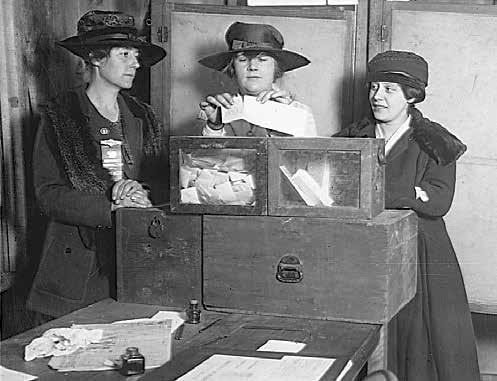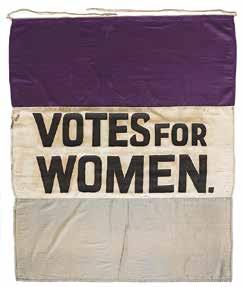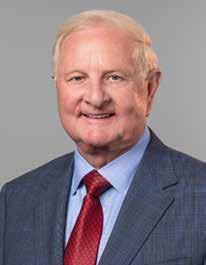
11 minute read
Ten Facts about the 19th Amendment
10 Quick Facts about the 19th Amendment
As we commemorate the 150th anniversary of the 19th Amendment, here are 10 interesting facts to check out. Did you know?
Advertisement
1Many leaders of the abolitionist movement to end slavery in the 19th century also supported woman suffrage in the twentieth century. Frederick Douglass and Sojourner Truth are examples.
2Many states granted women the right to vote in state and local elections in advance of the ratification of the Constitutional amendment. They included Wyoming, Utah, Colorado, Idaho, Washington, California, Oregon, Montana, Arizona, Kansas, Alaska, Illinois, North Dakota, Indiana,
Nebraska, Michigan, Arkansas, New York, South Dakota, and Oklahoma.
3While voting rights could no longer be denied because of race or sex, after the 15th and 19th Amendments, many voters still faced ballot restrictions, including registration rules, literacy tests, poll taxes, and moral and residency requirements.
4Doctor and mountaineer Cora Smith Eaton King planted a “Votes for Women” flag at the top of Mount Rainier, in Washington state, in 1909.
5The text that would become the 19th Amendment in 1920 was first proposed in Congress in 1878. 6 National suffrage organizations printed fliers in several languages besides English, including German, Polish, Italian, Yiddish, and French, in order to reach certain immigrant populations.

7In every presidential election since 1980, the proportion of eligible women who voted exceeded the proportion of eligible men who voted.
8As of 2018, there were 81.3 million women registered to vote in the United States. They make up 53% of the entire electorate.
9Wisconsin, Illinois, and Michigan were the first states to ratify the 19th Amendment, all on June 10, 1919, six days after it was approved by Congress.
10 Mississippi was the last state to ratify the 19th Amendment in 1984.

Be sure to join us on August 26, at Noon as the DBA celebrates Women’s Equality Day with a special event featuring Nina Totenberg. Register at www.dallasbar.org.
Source: The American Bar Association Division for Public Education; www.americanbar. org/groups/public_education/ programs/19th-amendment-centennial/ fun-facts/

Amount
1,500.00
Reference
NEW CASE
Card Number
**** **** **** 4242


Trust Payment IOLTA Deposit
POWERING PAYMENTS FOR THE LEGAL INDUSTRY
The easiest way to accept credit, debit, and eCheck payments
The ability to accept payments online has become vital for all firms. When you need to get it right, trust LawPay's proven solution.
As the industry standard in legal payments, LawPay is the only payment solution vetted and approved by all 50 state bar associations, 60+ local and specialty bars, the ABA, and the ALA.
Developed specifically for the legal industry to ensure trust account compliance and deliver the most secure, PCI-compliant technology, LawPay is proud to be the preferred, long-term payment partner for more than 50,000 law firms.
ACCEPT MORE PAYMENTS WITH LAWPAY 877-260-1115 | lawpay.com/dallasbar
Appellate/Antitrust & Trade Regulation
The Itsy-Bitsy Burden
BY JUSTICE CORY L. CARLYLE
You won at trial! But now you find yourself reading and re-reading the appellant’s brief, faulting you for things they say you did not do at trial, or if you did, did not do them right, and asserting some seemingly brand new faults the appellant found a way to raise. What to do to keep your verdict?
There is a line of cases that says an appellee—in certain situations—has waived arguments it made at trial when it fails to re-raise them in its appellate brief. There is another line of cases that says an appellee does not even have to file a brief to prevail. The latter is likely the better reasoned course, but diving into this odd little morass of appellate procedure is beyond the scope of this brief article. Today, I want to talk about what burden an appellee has in the intermediate appellate court and how to navigate it.
Generally, appellants face solid trial records from our talented trial bench that present real challenges. For that reason, appellants commonly raise direct challenges to the trial court proceedings in their briefs. These types of briefs take on the trial court’s reasoning or findings using its framework and ask us to come out the other way. This approach can be successful, and it may be the appellant’s only option.
But there are other ways appellants attack trial results. One is the subtle “burden-shift”. Another is the straw man. They are flavors of the same concept, which is how to win on appeal when things are stacked against you. We see others, but these top the very informal list I have compiled. I am frequently impressed by the way thoughtful advocates execute appellants’ briefs using these concepts. And let me not go another word without saying: appellants prevail on appeal at a relatively stable rate and this will almost certainly continue. We appellate courts exist for a reason, after all!
I will present a concrete example from an appellant’s reply brief: “Appellees do not dispute the absence of evidence to support X. That lack of proof requires a new trial.” The initial response may be: it certainly would have been helpful if appellee had addressed X in its briefing. But a closer look may reveal something altogether different: what appellant is calling X, appellee discussed as Y, and certainly addressed how much Y the jury heard. Appellant and appellee are talking past one another in that way stubborn advocates can, and if appellee is correct that its Y, appellant’s X, came up at trial in a way the trial court or jury could properly credit, then appellant is dead in the water. In a different case, appellant’s argument would be the basis for an easy reversal, but here, it is a red herring.
While the appellee has no specific burden, in this case, appellee ought to obviously, purposefully redefine the X in terms of Y. The appellee finds the best chance of prevailing by accepting the appellant’s challenge, confronting the way appellant has reframed the issues, and by rearticulating and un-reframing appellant’s reasons for the trial-level result. When appellee chooses only to respond to the appellant’s issues, on appellant’s terms, appellee may find peril, but not because appellee failed to meet some burden. It is this situation that raises the question on an appellee’s burden in briefing.
There are certain phrases that jump out, typically from the appellant’s reply brief, that suggest the appellant may be attempting to pin appellee down for things appellee has no real burden to do. These phrases will often center on an appellee’s failure to address a certain argument or failure to restate some basis for its triallevel success. Sometimes, the appellant will attempt to say appellee has conceded an argument either by not responding in a way appellant found satisfactory or by not re-raising the trial level argument. These phrases spark my interest. Though potentially problematic—or even fatal— to appellee apart from appellee’s failure to talk about them in the brief, they may also be appellant’s attempt to grasp victory from the jaws of defeat. These types of phrases should jump off the page for an appellee.
It is vanishingly rare that an appellee has “conceded” something by omission in its brief. The Texas Supreme Court has recently reemphasized its preference for merits adjudications over procedural defaults in the courts of appeals, and the view of briefing I discuss here falls in line with that emphasis. Appellee: address appellant’s arguments; bring it back to why you won. But on the off chance you miss something, remember: it is awful tough to climb up a waterspout in the rain.
Happy briefing! HN
Justice Cory L. Carlyle serves on the Fifth District Court of Appeals at Dallas and thanks attorneys Rachel Campbell and Bryan Bond for their excellent work in chambers.
Friday, August 14, Noon, Zoom THE EFFECTS OF ‘CRISIS FATIGUE’ O Kell N y R ATTOR entzel and Dr. NE Jana YS Rentzel www.dallasbar.org




22 Headnotes l Dallas Bar Association August 2020 In The News KUDOS Frank Carroll, PLLC., has been reelected as the Chairman of the Board of the Texas surer, Vice-President of Finance and member of the Executive Committee of Ann Massey Badmus launched Badmus & Associates located at 11325 Katherine A. Kinser, of Kinser & Bates, Board of Legal Specialization for 2020- the Richardson Symphony Orchestra. Pegasus Street, Suite E-265, Dallas, LLP, has been named as one of the 100 2021. He has also been honored as the Texas 75238. National Diplomates of the American recipient of the Distinguished Counselor Paul Stafford has been elected ChairCollege of Family Trial Lawyers. Award for 2020 presented by the AntiElect of the State Bar of Texas AfricanAnna Lee Alford and David L. Pratt trust and Business Litigation Section of American Lawyers Section for 2020- joined Bradley Arant Boult Cummings Chris Schwegmann, of Lynn Pinker the State Bar of Texas. 2021. LLP as Associate and Partner, respecHurst & Schwegmann, has been elevated tively. to named partner. Harriet Miers, of Locke Lord LLP, Britney E. Harrison, of GoransonBain received the Louise Raggio Women’s Ausley, has been elected President of Sarah R. East and Brenda A. HardQuentin Brogdon, of Crain Brogdon RogLegal Advocate award from Legal Aid the Texas Young Lawyers Association Wilson joined Higier Allen & Lautin, ers, LLP, was invited to become a Fellow of Northwest Texas at the 20th Annual (TYLA) for 2020-2021. P.C. as Associates. of The International Society of Barristers. Monica Latin, of Carrington, Coleman, Sloman & Blumenthal, has been named Managing Partner. Meyling Ly-Ortiz, of Toyota Motor N. America, Inc., was selected by The AssoWomen’s Advocacy Award virtual event. Shonn Brown, of Kimberly-Clark Corporation, received the Business Leadership Award from Legal Aid of Northwest Texas at the 20th Annual Women’s Advocacy Award virtual event. Paul Genender, of Weil, Gotshal & Manges LLP, has been selected by the Dallas Women Lawyers Association (DWLA) to receive its James E. Coleman Jr. Her Champion Award in recognition of his support and dedication to advancing women in the legal profession. Ross Robinson, David Lovell, Robert McCormick and David Odom joined Shackelford, Bowen, McKinley & Norton, LLP as Partners. Stan Moore joined the firm as Of Counsel. News items regarding current members of ciation of Corporate Counsel’s Top 10 30-Somethings in 2020. Neil J. Orleans, of Ross & Smith, P.C., has been appointed Chair of the NorthON THE MOVE the Dallas Bar Association are included in Headnotes as space permits. Please send Park Presbyterian Church Investment Jared W. Hays joined Bell Nunnally & your announcements to Judi Smalling at Frank Carroll, of The Law Offices of Wm. Committee. He also was reelected TreaMartin LLP as Partner. jsmalling@dallasbar.org
THURSDAY, AUGUST 6, N OON , ZOOM Kilgore Law Firm Kicks Off
AN D S T I L L T H E Y R O S E : 2021 EAJ Campaign E AR L Y AF R I C AN AM E R I C AN L AWY E R S I N D AL L AS AN D CONTINUED FROM PAGE 1 unheard and forgotten. Whether your passion is to better our community on T H E L O N E S T AR S T AT E Rosewood Property Company, added: a micro or macro level, the EAJ Cam“I am honored to serve as one of the paign is a direct way to make that
John Browning and Hon. Carolyn Wright Co-Chairs of the EAJ Campaign impact.” MCLE 1.00 because the work of the Campaign directly impacts our community; withThe EAJ Co-Chairs will be ably assisted by Honorary Chair Jeffrey out the Campaign, thousands of people Melucci, Senior Vice President and www.dallasbar.org who cannot afford an attorney would General Counsel of Kimberly-Clark not be able to have their interests Corporation, and Vice Chairs Stewart represented. At a time when so many Clancy of Capital One; Olesja Cormhave found themselves out of work ney of Toyota; and Amy M. Stewart of or with reduced pay, the services that Stewart Law Group.
DBA Bench Bar the Campaign supports are even more crucial and needed. This year we will have some new and fun ways for you to support the Campaign, including an The commitment of Dallas attorneys and the DBA to the Equal Access to Justice Campaign is impressive. Since 1997, the DBA and Legal Aid
Conference IS online event. Stay tuned for details!” In today’s environment, this year’s Campaign is more important than ever, as noted by Ms. Ly-Ortiz, Managing Counsel-Labor & Employment have joined forces to raise money for the program, with Dallas lawyers donating almost $15 million. DVAP is a joint pro bono program of the DBA and Legal Aid of North
GOING VIRTUAL! at Toyota Motor North America: “On a societal level, especially against the backdrop of systemic racism, supporting equal access to justice and providing pro bono legal services to West Texas. The program is the only one of its kind in Texas and brings together the volunteer resources of a major metropolitan bar association with the legal aid expertise of the largthose who are underserved and underest and oldest civil legal aid program Thursday, SEPTEMBER 24 th | 10 AM - 3 PM privileged is just one tangible way to address the inequity in our country. On in North Texas. For more information, or to donate, visit www.dallas Friday, SEPTEMBER 25 th | 10 AM - 3 PM a personal level, providing and funding pro bono services is an invaluable way volunteerattorneyprogram.org. HN to see, hear and acknowledge those in Michelle Alden is the Director of the Dallas Volunteer Attorney
The 2020 DBA Bench Bar Conference is moving online. our community who are often unseen, Program. She can be reached at aldenm@lanwt.org. Join us for 5.5 hours of engaging CLE and the presentation of the Trial Lawyer of the Year Award to Windle Turley. Registration Fee: $100 View full program & Register
At Dallasbar.org




